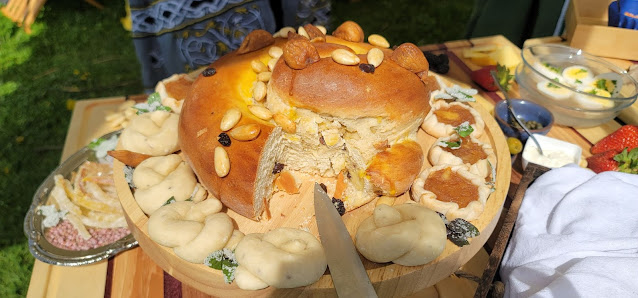
.lxxxxj. Vyolette – Violet Almond Pottage
.lxxxxj. Vyolette – Violet Almond Pottage
This pottage blends fragrant violet flowers with thickened almond milk and sweet stewed fruits—a historic, lightly spiced dish drawn from Two Fifteenth-Century Cookery-Books. While not as beloved as its cousin recipe Cxxv. Vyolette, this warming dish remains visually striking and period-appropriate for a historical reenactment feast.
Original:
.lxxxxj. Vyolette.—Nym Almaunde Mylke, an flowre of Rys, and pouder Gyngere, Galyngale, Pepir, Datis, Fygys, & Rasonys y-corven, an coloure it with Safroun, an boyle it & make it chargeaunt; an whan þou dressyste, take þe flowres, an hew hem, an styre it þer-with; nyme þe braunchys with þe flowres, an sette a-boue and serue it Forth.
Interpreted Recipe (8 servings)
- 4 cups almond milk
- 1/2 cup rice flour
- 1 tsp ground ginger
- 1/2 tsp each ground galingale and pepper
- 24 figs, minced
- 24 dates, minced
- 2 cups raisins
- Pinch of saffron
- Fresh violet flowers (Viola odorata), chopped, with sprigs reserved for garnish
Instructions:
- Warm almond milk with saffron over low heat until colored.
- Add spices, fruits, and simmer until fruit is soft (about 7 minutes).
- Whisk in rice flour, stirring constantly until thickened to a porridge consistency.
- Cool slightly, fold in chopped violet petals, and serve with violet sprigs on top.
Kitchen Notes
This dish resembles a medieval breakfast porridge more than a dessert. The almond broth is subtly sweet, spiced, and filled with softened fruit. Violet flowers stirred in at the end retain their color and provide a soft floral finish.
Compared to the more custardy version of Cxxv. Vyolette, this is heartier and less dessert-like, but still appropriate for a spring feast or vigil.
Related Floral Recipes
- Rede Rose – A rose custard with egg yolk and almond milk
- Cviij. Prymerose – Primrose flower with ginger and saffron
- Cxxviij. Flowrys of Hawthorn – Prepared in the same style as vyolet
Flower Usage in Medieval Cooking
Violets, especially Viola odorata, were prized for their scent and beauty. They were used not only in sweet syrups but in stews and broths to signal elegance and freshness. Only scented violets were considered culinary-safe in the Middle Ages.
Refer to our full guide: Flavors of the Flower: 5 Medieval Recipes Using Edible Blooms
Edible Flower Safety Chart from Agnes deLanvallei:
Medieval Herbs We Grow Chiefly as Flowers (archived)
Labels: violets, medieval recipe, almond pottage, edible flowers, 15th century food
Further Reading: Of March Violets
Explore the poetic and symbolic legacy of violets in “Of March Violets”, a companion piece reflecting on the fragrance, folklore, and meaning of this beloved bloom in medieval and modern imagination.
Whether you're reconstructing a medieval banquet or adding floral flair to a modern meal, edible flowers are a fragrant and flavorful way to connect with the past. These recipes remind us that beauty and sustenance were deeply intertwined in historical cuisine—and they invite us to continue that legacy in our own kitchens today.
⚠️ Reminder: Always use organically grown or culinary-grade flowers. Never consume flowers from florists or treated ornamental plants.
References & Resources
- Parkinson, John. Paradisi in Sole Paradisus Terrestris (1629). A foundational English gardening text blending botanical, culinary, and medicinal knowledge. Read on Project Gutenberg.
- A Book of Fruits & Flowers (1653). A 17th-century household manual offering flower-based recipes for food, drink, and medicine. Read on Project Gutenberg.
- MedievalCookery.com. Searchable transcriptions of medieval English and European cookbooks.






